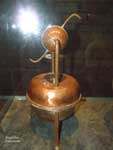.
Heron von Alexandria, Biographie, Erfindungen, Wissenschaft
Part 1
Heron from Alexandria (Heron Alexandrinus) was a Mathematician, Physicist and Engineer who lived in 10-70 AD but some references consider also 150 AD which is probably wrong, as in one of his works he referred to a recent eclipse which is now thought to have occurred in 13 March 62 AD. From Heron's writings it is reasonable to deduce that he taught at the Museum in Alexandria. His origin is uncertain although he wrote in Greek on the measurement of geometric figures and invented many contrivances operated by water, steam, or compressed air, including a fountain and a fire engine.
Image of Heron of Alexandria Of course this is not a real but a hypothetical portait of Heron!
Known as Michanikos, the Machine Man, Heron invented the world's first steam engine, developed some sophisticated surveying tools, and crafted handy gizmos like a self-trimming oil lamp. Technically speaking, Heron's clever inventions were particularly notable for their incorporation of the sorts of self-regulating feedback control systems that form the bedrock of cybernetics; like today's toilets, his "inexhaustible goblet" regulated its own level with a floating mechanism. But what really stirred Heron's soul were novelties: pneumatic gadgets, automata, and magic theaters, one of which rolled itself before the audience on its own power, cranked through a miniature three-dimensional performance, and then made its own exit. Another staged a Dionysian mystery rite with Apollonian precision: Flames lept, thunder crashed, and miniature female Bacchantes whirled madly around the wine god on a pulley-driven turntable.
Erik Davis - Techgnosis: Myth, Magic & Mysticism In The Age Of Information
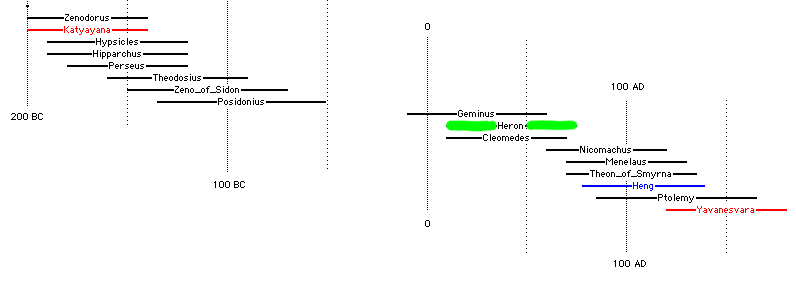
Timeline: Heron of Alexandria and other ancient scientists (mainly mathematicians) from http://www-groups.dcs.st-and.ac.uk/~history/Timelines/index.html
Heron’s Books
· Automata (in Arabic Translation) (Greek: moving itself) (lat. De automatis). A collection of constructions called miracles (thaumata) for temples. Heron describes automatic rotating objectives, noise such as thunder, automatic opening doors. Philon from Byzanz describes the existence of automata in his book Mechaniki syntaxis, that includes pneumatic apparatus and automatic astronomical devices as early as 300 BC.
· Catoptrica geometric linear propagation of light, reflection, use of mirrors. A PDF File in German with reference to the Catoptrica.
· Dioptra (in Arabic Translation) (Greek word for a instrument to see through). A collection of constructions for the determination of lengths from a distance. Heron describes constructions similar to the Theodolit used for measurements of angles and other devices such as the odometer used to measure distances.
John F. BROCK in Pyramids to Pythagoras: Surveying from Egypt to Greece – 3000 B.C. to 100 A.D. gives a description of the content of Heron's Dioptra book:
1) and 2) Introduction to “the science of dioptrics”.
3) and 4) Instructions on how to construct a dioptra instrument.
5) Instructions on how to produce a stave for measurement.
6) To observe the difference in height between two points or if their height is the same.
7) To draw a straight line by dioptra from a given point to another invisible point, whatever the distance between them.
8) To find the horizontal (pros diabeten) interval between two given points, one near us, the other distant, without approaching the distant one.
9) To find the minimum width of a river while staying on the same bank.
10) To find the horizontal interval between two visible but distant points, and their direction.
11) To find a line at right angles at the end of a given line, without approaching either the line or its end.
12) To find the perpendicular height of a visible point above the horizontal plane drawn through our position, without approaching the point.
13) (a) To find the perpendicular height of one visible point above another, without approaching either point. (b) To find the direction of a line connecting two points, without approaching them.
14) To find the depth of a ditch, that is the perpendicular height from its floor to the horizontal plane either through our position or through any other point.
15) To tunnel through a hill in a straight line, where the mouths of the tunnel are given.
16) To sink shafts for a tunnel under a hill, perpendicular to the tunnel.
17) To lay out a harbour wall on a given segment of a circle between given ends.
18) To mound up the ground in a given segment of a spherical surface.
19) To grade the ground at a given angle, so that on a level site with the shape of an equal-sided parallelogram its gradient slopes to a single point.
20) To find a point on the surface above a tunnel so that a auxiliary shaft can be sunk.
21) To lay out with the dioptra a given distance in a given direction from us.
22) To lay out with the dioptra a given distance from another point, parallel to a given line, without approaching the point having the line on which to lay it out.
23) to 30) The first five chapters refer to the dioptra setting out irregular shaped plots of land, while the remaining three explain how to determine the areas from those figures.
31) To measure the discharge or outflow of a spring.
32) and 33) Describes how to utilize the dioptra in a vertical mode for the purposes of astronomical observations.
34)This chapter informs the reader about the usage of another measuring instrument called the odometer, which has a device fitted to the wheels of a carriage such that the horizontal distance is evaluated in a very similar fashion to which a modern day perambulator gives distance
LEWIS, M.J.T., Surveying Instruments of Greece and Rome, (Cambridge University Press, 2001)
· Metrica (in Arabic Translation) A collection of 3 books for the determination of areas and volume of objectives. Part 1 considers the area of triangles and other polygons with 4-12 sides, Surfaces of pyramids, cylinders, spheres etc. Part 2 considers the volume of sphere, cylinder, prisms, pyramids etc. Part 3 considers the division of areas and volumes in parts. He gives a method fort he determination of the cubit root and calculates the cubic root of 100.
· Pneumatica (Spiritalia) Two books, A collection of around 80 mechanical apparatus, that work with air, steam or hydraulic pressure. This includes a fire extinction apparatus, automata that provide water if a coin is inserted and the first steam engine (Aeolipile). The Heronball, Thermoscope, Syphon, Fontain, and Aeolipile. 1899 Edition in Greek
· Belopoeica A Collection of war machines. The original manuscript did nor survive but medieval handwritten copies exist. 1918 Version in Greek
· Mechanica 3 Books of how to move heavy objects. Part 1 provides the basis of statics and dynamics. Part 2 shows 5 simple machines. Part 3 describes lifting machines and pressures. Mechanica 1999 Edition
Other books possible also from Heron are
· Geometrica A collection of equations and exercises based on the first chapter of Metrica.
· Stereometrica. Examples of three dimensional objectives based on the second Metrica Chapter.
· Mensurae. Objects that can be used for measuring based on Stereometrica and Metrica.
· Cheirobalistra. (xeiroballistrwn kataskeuh kai summetria.) A Part of a lexicon about Catapults.
Heron’s Aeolipile (Wind or Steam ball)
A modern version can perform more than 3500 rotations per minute
An Aeoli- What?!? (A Science Project)
Two more drawings and the Giovani Bianca Steam engine
Heron, described in detail what is thought to be the first working steam engine, which was obviously not very efficient. He called it an aeolipile, or "wind ball". His design was a sealed caldron of water was placed over a heat source. As the water boiled, steam rose into the pipes and into the hollow sphere. The steam escaped from two bent outlet tubes on the ball, resulting in rotation of the ball. The aeolipile is the first known device that could transform steam into rotary motion. The principle he used in his design is similar to that of today's jet propulsion. Heron did not consider this invention being useful for everyday applications but rather as a novelty, a remarkable toy. With this steam engine one could open the gates of a temple. Why the Greeks did not consider this machine as a possibility for an engine is its low efficiency but the prototypes often are not efficient. There are other reasons why machines were not used. See: http://www.history.rochester.edu/steam/hero/section50.html , http://www.geocities.com/Athens/Acropolis/6914/heroturb.htm A Quicktime Movie
The steam engine reappeared again only in 1698 when Thomas Savery invented a steam pump. The first practical steam engine was the atmospheric machine of Thomas Newcomen in 1701. It was used to operate pumps on coal mines. In 1804, English inventor Richard Trevithick introduced the steam locomotive in Wales. In 1815, George Stephenson built the world's first workable steam locomotive. A jet propelled wagon utilizing the aeolipile appeared in early textbooks on the evolution of the horseless carriage.
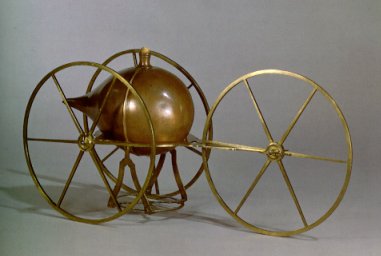
Jean-Antoine Nollet, Leçons de Physique Expérimentale, 1764, Vol. IV
The simple technology was not sufficient to power horseless carriages. Denis Papin (1647-1712) who invented 1679 the pressure cooker and in 1690 published his first work on the steam engine in De novis quibusdam machinis knew the aeolipile from Heron's pneumatica, translated by Gottfried Wilmhelm Leibniz (1646-1716), Germany.
Want to try and make an aeolipile yourself? Find a complete illustrated manual at. Scitoys
THE GROWTH OF THE STEAM-ENGINE especially SECTION I. - The Period of Speculation - Hero to Worcester
See also: Apparatus to produce motion of figurines by means of heat
Heron’s Odometer (οδόμετρο) (a ancient taximeter)

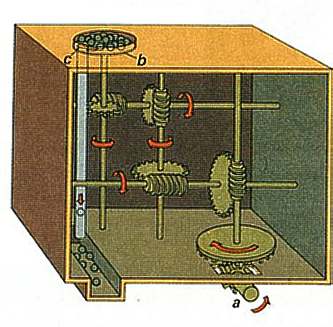
An odometer is a device used for indicating distance traveled by a vehicle. Vitruvius around 27 and 23 BC describes such a device although the actual invention may have been by Archimedes during the First Punic War. Hero also describes an odometer in chapter 34 of his Dioptra. Chariots with wheels of 4 feet diameter turns exactly 400 times in one Roman mile. For each revolution, a pin on the axle engage a 400 tooth cogwheel, thus making one complete revolution per mile. This engages another gear with holes along the circumference, where pebbles (calculus) are located, that drop one by one into a box. The number of miles travelled is given simply by counting the number of pebbles. Whether this instrument was actually built is disputed. Leonardo da Vinci tried to build it according to the description, but failed.
André Wegener Sleeswyk, "Vitruvius' Odometer", Scientific American 245(4) October, 1981, pp. 188-200

Odometer for Ships of Archimedes according to Heron
http://www.database.com/~lemur/rb-rolling-ball.html
Philosopher's stone

Automatic goblet
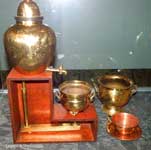
Baroulkos
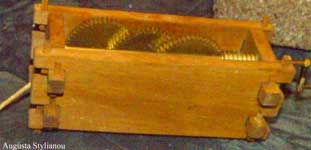
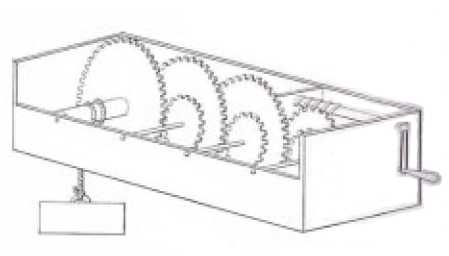
The baroulkos, is a weight-lifter in which a succession of gears makes it possible to lift large weights with small effort by turning a crank.
Heron’s Cheirobalistra
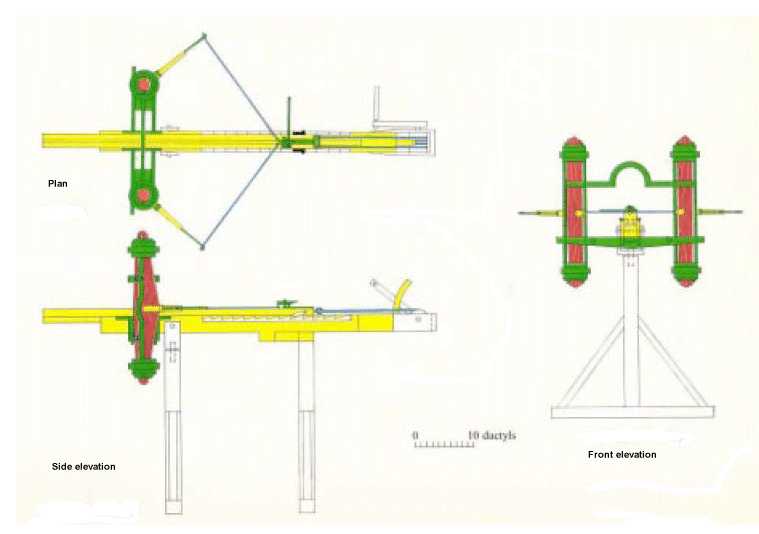
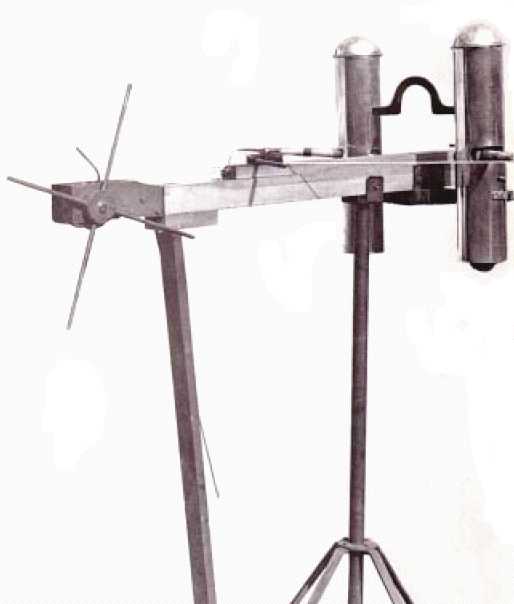
The cheiroballistra as reconstructed by E. W. Marsden
The Cheiroballistra (called Manuballista by the Romans), a device that hurls arrows over a large distance. Some say that it was actually written around 100 AD (after Heron). As an inventor Apollodorus of Damascus is proposed working for the Roman army.
In this particular engine, the springs are stretched in two separate metal casings. A metal stud was attached the top of each of the field frames, to hold them together. Another stud was attached to the bottom of the field frames and the base of the engine, to hold the spring casings in place (Marsden 209). Heron's cheiroballistra represents the most advanced two-armed torsion engine used by the Roman army.
Reference from ANCIENT ROMAN ARTILLERY
Reconstruction of the Cheiroballistra, Read also the translated Greek text of the Cheiroballistra
Another Version in Russian with more drawings!
See Ancient Greek Catapults from Scientific American
Palintonon stone-thrower
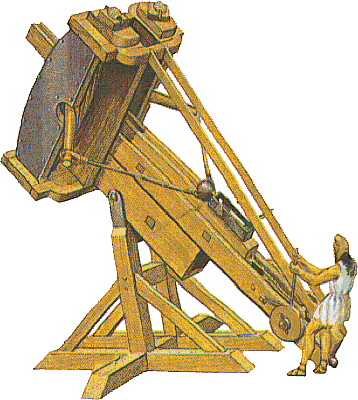
See: Ancient Greek Artillery Technology
Dioptra
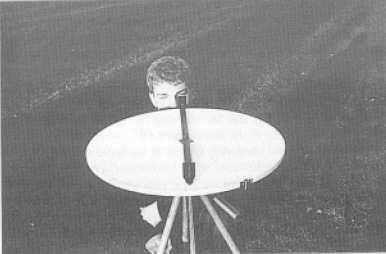
Reconstruction of a Greek dioptra (surveying instrument)
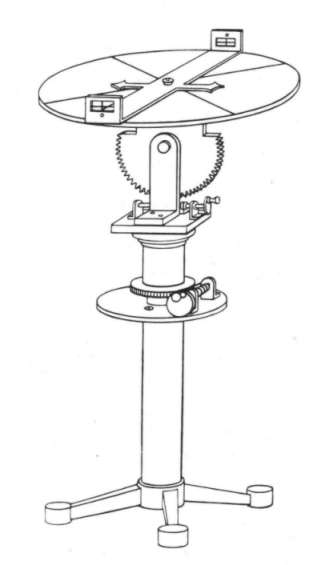
Reconstruction of Heron's dioptra from Schöne, Hero Alexandrinus. Heronis Alexandrini opera quae supersunt omnia. Vol. III: Rationes dimetiendi et commentation dioptrica. Griechisch und Deutsch H. Schöne. - Leipzig: B. G. Teubner, 1903.
Dioptra a surveying device using triangulation long before English mathematician Leonard Digges' 16th-century telescopic theodolite, which was used in navigation, surveying and civil engineering to determine the direction of roads, tunnels or other structures.
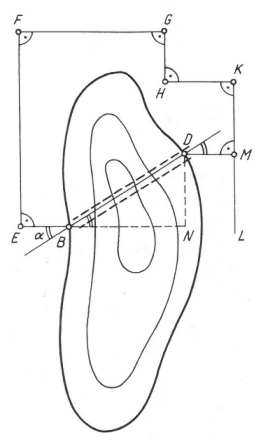
Example by Heron how to use the Dioptra to construct a tunnel through two opposite points in a mountain. Take a point close to the first entrance B and another point E. Then use the Dioptra to obtain the perpendicular line EF and through a set of other perpendicular segments get line segment KL the point M for which DM is perpendicular to KL, where D is the other opposite entrance point. Using DN and NB estimate the angle alpha necessary to connect points B and D. The tunnel of Eupalinos shows that even 500 years before the Greeks have the knowledge and devices to produce such tunnels.
Heron's “automata” ( Περὶ αὐτοματοποιητικῆς )
Heron describes the workings of several bird automatons. Fragments of Heron's writings were the first of the Greek works to be translated. These appeared for the first time in Latin in the work of Giorgio Valla, published in 1501, followed by complete translations into Latin by Comma dini in 1575. The single work which provoked the greatest interest among Renaissance scholars was the Pneumatics, which was translated and published for the first time by Giovanni Battista Aleotti in 1589 under the title Gli Artificiosi et Curiosi Moti Spiritali dit Herrone, and in which the translator incorporated some ideas of his own. Other versions followed quickly, the best known being that by Alessandro Giorgi da Urbino of 1592 and 1595.
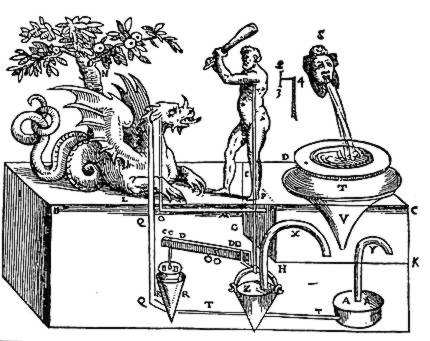
Reconstruction of one of many “automata” of Heron by Giovanni Battista Aleoti 1589. Hercules and the Dragon. When Hercules hits the head of the dragon the dragon shoots water on his face.
See also: http://www.history.rochester.edu/steam/hero/section40.html
A automatic device that opens the temple door if a fire burns on a altar
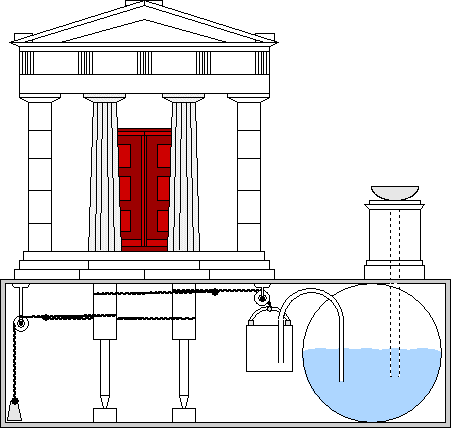
Animated Image by P. Hausladen, RS Vöhringen
See: http://www.history.rochester.edu/steam/hero/section37.html
Heron's Mobile Automaton (Real Audio Video) In Greek

moving a device using potential energy

-MARVELOUS ALTAR (According to Heron).
"Fire being lighted on an altar, figures will appear to execute a round dance. The altars should be transparent, and of glass or horn. From the fire-place there starts a tube which runs to the base of the altar, where it revolves on a pivot, while its upper part revolves in a tube fixed to the fire-place. To the tube there should be adjusted other tubes (horizontal) in communication with it, which cross each other at right angles, and which are bent in opposite directions at their extremities. There is likewise fixed to it a disk upon which are attached figures which form a round. When the fire of the altar is lighted, the air, becoming heated, will pass into the tube; but being driven from the latter, it will pass through the small bent tubes and ... cause the tube as well as the figures to revolve."
See Puppet Shows among the Greeks

The "Staton" Automatic Theater,
Part 2 (More Inventions, References, Links)
| Ancient Greece
Science, Technology , Medicine , Warfare, , Biographies , Life , Cities/Places/Maps , Arts , Literature , Philosophy ,Olympics, Mythology , History , Images Medieval Greece / Byzantine Empire Science, Technology, Arts, , Warfare , Literature, Biographies, Icons, History Modern Greece Cities, Islands, Regions, Fauna/Flora ,Biographies , History , Warfare, Science/Technology, Literature, Music , Arts , Film/Actors , Sport , Fashion --- |

